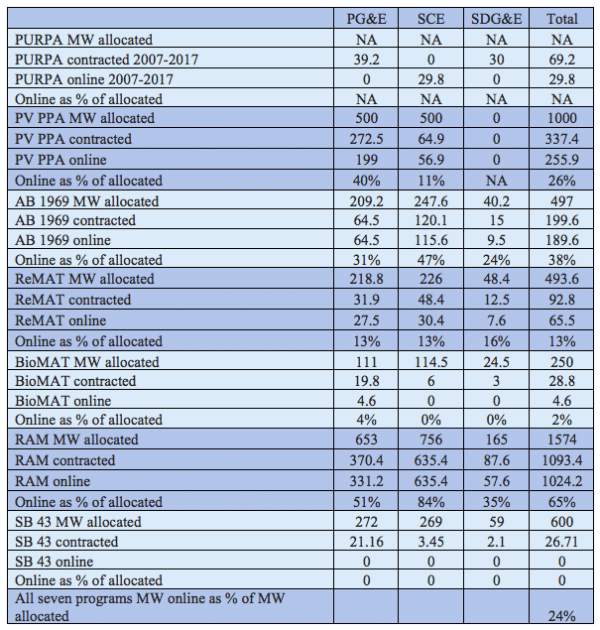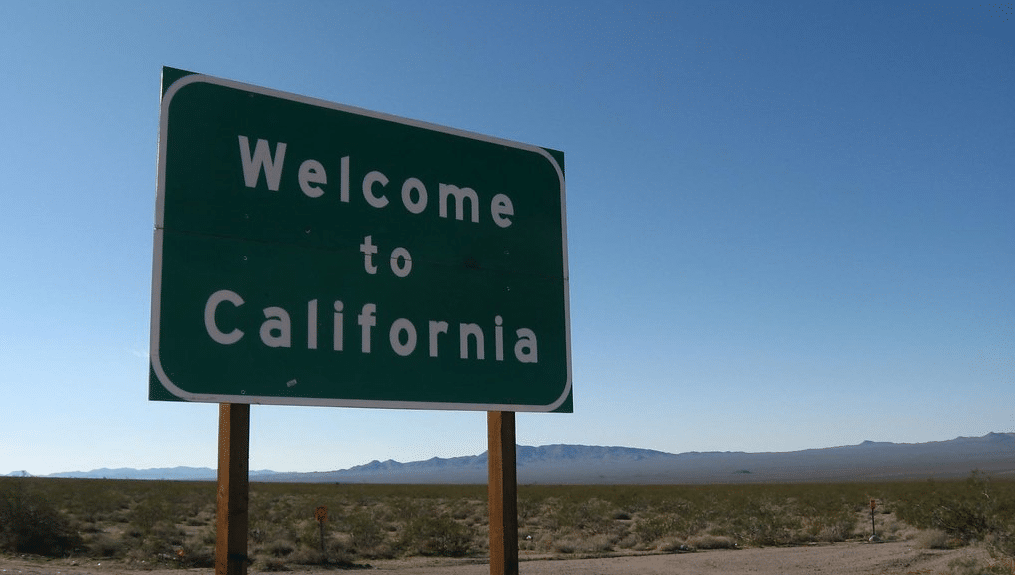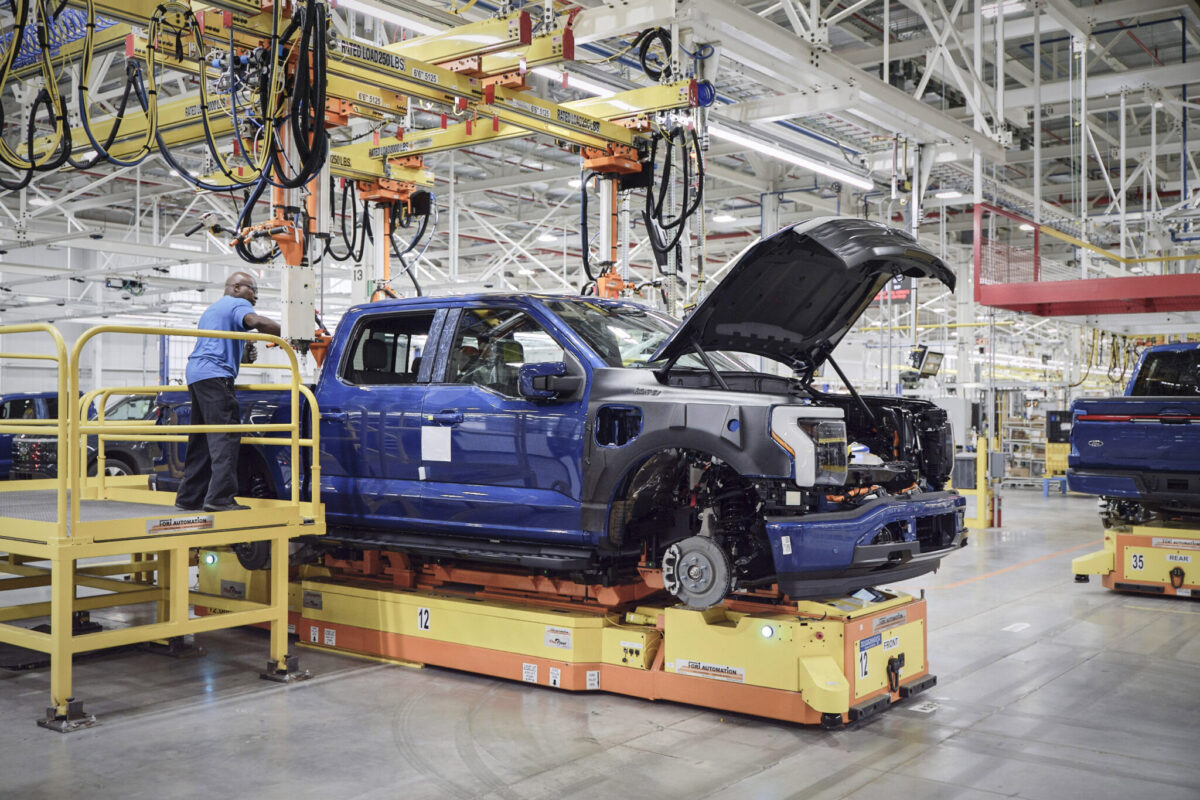California, long a progressive leader on renewable energy and climate change mitigation, has neglected a key market segment for renewable energy: the community-scale or wholesale distributed generation market.
The wholesale distributed generation segment consists of projects below 20 megawatts that connect to the distribution grid and export power to the grid for sale.
These kinds of projects are large enough to make a difference to the state’s ambitious climate change and renewable energy mandates, but also enjoy low costs and much lower environmental impacts than projects bigger than 20 megawatts, the latter being the historical default in California for meeting state renewable energy goals.
For example, a five-megawatt solar project occupies about 30 acres of land and can be located closer to load in urban pockets, on already-disturbed land, or on large buildings and parking lots. The largest-scale solar projects have much greater environmental and grid impacts. For example, the 550-megawatt Topaz Solar Farm in San Luis Obispo County occupies over seven square miles of land and is located far from the load centers where power is consumed.
There is an increasing pushback on large-scale solar and wind power, due to their large impacts. For example, San Bernardino County, California’s largest county and the focus of much solar power development, has passed new rules that would severely restrict large-scale solar developments on private land, but would allow “community-oriented renewable energy.”
Similar restrictions are increasingly being applied in other counties and for federal lands in California, such as the Desert Renewable Energy Conservation Plan completed in 2016, which has had the effect of stifling new large-scale solar and wind power projects in favor of conservation of natural habitats.
In short, community-scale renewables enjoy the cost advantages of much larger projects without much of the environmental impacts or need for new transmission lines and associated costs. The community-scale market segment combines the benefits of the small-scale and utility-scale market segments, without the downsides.
Unfortunately, most of California’s programs targeting this key market segment have struggled or failed. Since the 1990s this market segment has been a modern Cinderella waiting for its prince.
This disparity has come about because California’s energy policy is dumbbell-shaped, with strong support for small-scale and utility-scale renewables. In contrast, the community-scale market segment has been plagued by ongoing policy neglect, and otherwise poor policy choices.
The Green Power Institute (GPI), part of the nonprofit Pacific Institute, produced a 2019 report, A Modern Cinderella Story: Assessing the state of California’s “community-scale” renewable energy market. The report does a deep dive into the last decade of experience in California’s programs focused on wholesale distributed generation (“community-scale renewables”).
The following table from the report summarizes seven key wholesale DG procurement programs from the last decade and shows that most have largely failed, for various reasons:

It is not too late for this neglected market segment to find its prince. Will policymakers heed the track record of demonstrated failure and finally create new programs that address previous problems?
The Public Utilities Commission scoped what to do about the main community-scale power program, ReMAT, over two years ago. But still no action has been taken. Developers are leaving the state and looking for greener pastures.
It’s starting to look like the PUC and other policymakers are not just neglecting this segment, but may in fact be trying to kill it off. This is both bad policy and unfair to communities and developers who believed California’s rhetoric about the potential for community-scale energy. It’s time for the PUC to get off the dime and fix this program, and live up to the rhetoric.
***
Tam Hunt is a renewable energy lawyer and policy expert, owner and founder of Community Renewable Solutions LLC, and author of the book, Solar: Why Our Energy Future Is So Bright, soon to be released in its second edition.
The views and opinions expressed in this article are the author’s own, and do not necessarily reflect those held by pv magazine.
This content is protected by copyright and may not be reused. If you want to cooperate with us and would like to reuse some of our content, please contact: editors@pv-magazine.com.








“For example, a five-megawatt solar project occupies about 30 acres of land and can be located closer to load in urban pockets, on already-disturbed land, or on large buildings and parking lots.”
Exactly, micro-grids are more efficient than centralized generation with distribution over power corridors. Just by having a micro-grid at the edge of town with energy storage could increase the efficiency of the local grid by 10% by getting rid of transformer step losses from HV of around 133KV to lower feed voltages like 12.8KV into the community. PG&Es PSPS and several communities creating their own CCAs will drive the installation of micro-grids near communities for better power stability in the future.
The average today seems to be 5MWp per 30 acres of land or around 167kWp per acre. Get solar PV panels to that tandem cell 35% efficiency and one could have 192kWp per acre and around 8.5MWp on the same land.
“It’s starting to look like the PUC and other policymakers are not just neglecting this segment, but may in fact be trying to kill it off. ”
Past allegations against board members like Paul Clanon, Mike Floria, Michael Peevy speaks to “gaming the system”. They are gone, but who was appointed in their places?
The community-scale market segment appears to be burying heads into the sands , because that segment is being increasingly dominated by industrial generator makers .
Industrial generators typically generate between 100KW to 20Mw . They are not your backyard type back up generators.. They are housed in trailers to be towed anywhere a lot of juice is required by anyone. They re being used to connect to substations as well.
The other possible reason is that solar rooftop companies are probably making sure that there is no competition from that segment by making sure that no local policymakers would consider them.
I suspect that most of people as well as investors are more keyed up about industrial generators than that segment despite climate change or carbon free promises made by politicians.. You see, poitiicians only point to the utilities as the goal to be carbon free while ignoring industrial generators as a big source of climate change. Rooftop solar is being touted as the solve all which it is not. . Politicians are understandably eager to create jobs at any costs to the taxpayers’ own ires..
Maybe that segment is too cumbersome to manage despite its lower costs , because of security issues like vandalism or sabotage/thievery. Industrial generators can be installed inside the fences of the substations and they dont take up much space.. Yet, they take up a lot of clean air space where we need to breath freely.
California is host to scores of refineries and chemical plants that even liberals seem to be so loathe to abandon in the name of climate change, anyway.
They just figure that they can balance things out during the while making progress to carbon free future which clearly mean much longer time lead than we would be led to think.
Bay Area is teetering with at least half dozen refineries. So the more reasons we need to keep them to feed fuel to the yet to come hordes of industrial generators that will be required to keep the expected hordes of EVs yet to hit the roads in California in the coming decade or two.
We are still unaware that solar rooftops and utility scale farms or your so called dumbell scheme will still be inadequate to address the demand for charging millions of EVs in the future.. Politicians appear to be resigned to the inevitability of industrial generators as the practical solution to that.
We already had thousands if not tens of thousands of industrial generators installed here in California.. Who is counting? I am only guessing.. Yet, the politicians do not bother to attack them at all and they are still allowing more new industrial generators to be installed in the future .. Just do not believe what they are saying about carbon free goals not only here in Califiornia but all other states where they are mentioned if at all. this is still feeble effort!
Probably, no wonder, we don t want to touch community solar segment because this might trample into the turfs of industrial generator makers..
I have a lot of more arguments to make like asking how we will have enough solar energy for heating homes .. It looks to me like everyone is assuming that we can use natural gas or firewood to fuel our home furnaces and that we probably do not bother to take under consideration how we can harness solar energy to replace natural gas and firewood for our furnaces. Not only that, I ask how come we still continue to rely on firewood and even supportive of it despite its unhealthy outcomes . We continue to tout firewood as “renewable ” which I find quite intoxicating ! Moreover, we probably cannot rely on storage for home furnaces. because they consume so much energy in terms of Btus (British Thermal Units) So if we convert Btus into kilowatts, we will be surprised at how many more kilowatts it takes to power a typical home furnace .
Again , I ask why we still continue to allow or encourage firewood consumption .
Plus, we are expecting more EVs coming that will require more electricity . We have so much work to do to fix climate change.. We are thinking small and talking big that it is not, yet..
Energy efficiency is also a part of the “all encompassing electrification” of the U.S.. Ground heat exchange air conditioning systems can heat/cool a home efficiently and also be used to preheat water for domestic use. By getting away from an air conditioning unit that uses 1.5kWh to 1.3kWh per ton of air conditioning, one could get the efficiency of a ground heat exchange unit into the 750/Wh to 1kWh per ton. Direct resistive heating is around 3.5kWh per ton. As far as energy consumption goes, I’d rather have a ground heat exchange system that would run a 5 ton equivalent of 120kWh/day with domestic water pre heating than an electric heating coil at 420kWh/day.
As far as ‘policy’ goes, FERC just released its order 841 that allows energy storage at the wholesale generation level. The “portable” generators you speak of have limited useful maximum power output times due to limited on board fuel. Maybe 10 hours on a full tank, then its refuel or do without. One could put a stacked energy storage system in the confines of most switching stations that could accommodate 1MW of output generation with 4 to 8 MWh of energy storage on site. Stack two side by side, get 2MW and 4 to 8 MWh, control the output judiciously and one could power some circuits for several hours up to a day with storage.
Solarman, it is complicated .. my biggest concern is supercharger stations for EVs as I am sure that practically every town will have at least one station that serves several EVs at once . Charging an EV fast like a hour may require 75 to 150 KWh per EV . We will still be seeing gasoline tankers driving up to refill the same underground gasoline tanks in converted fast charger stations that were previously used for ICE vehicles.. Industrial generators will be placed there to serve EVs.. This is my main concern!!
Brett Kuntze: I believe it will be the Government themselves that may just adopt the 800VDC fast charge technology in order to charge electric vehicles at the same facilities that fuel ICE vehicles today. These are commercial centers with electric feeds that can be in the 480VAC three phase. Feeding this 480VAC MCC is usually a 7KV to 12.8KV transformer from the utility. The 12.8KV feed could make about 16 800VDC charging stations, just like current station/mini-marts have 16 fuel pumps onsite. Using the same standard used to ‘fuel’ up an EV in the 10 minutes one spends in a gas station now, can allow the fast charge of one’s vehicle, the Government will be happy to charge a road and maintenance tax on every gasoline equivalent charged and the onerous and probably unfair yearly road taxes proposed by Legislatures for electric vehicles would be unnecessary. Overall using 12.8KV to charge would more than likely save more energy than using a stepped down 480VAC to pump gas from a tank into a vehicle.